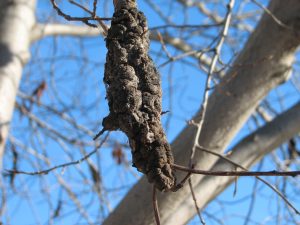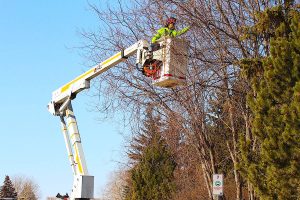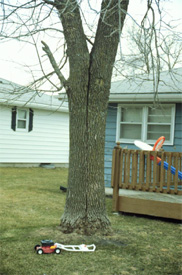
As alberta.ca describes “Black Knot is caused by the fungus Aspiosporina morbosa, is a very common disease of plants in the Genus Prunus” (Ramen.Samantha www.alberta.ca/blackknot)
It effects popular trees like the Mayday Tree, Amur Cherry, Nanking Cherry and Flowering plum. All of these trees come from the “flowering plant in the Rosaceae family” (en.wikipedia.ca). The fungus typically starts in April to June as it becomes more aggressive in the wetter months. It looks like blistering sections of the lower trunk and hanging dark burned sections of the upper canopy. It tends to build up within the crotches of the vectors and can spread quickly with low airflow. Black knot fungus can been seen best in the winter when foliage has been shed and the contrasting colors can bring out the blistered effected areas. This fungus can be spread easily by flying insects or birds visiting the canopy, improper pruning practices, improper removal of cuttings, or simply planting too many of one species. The dark “gulls” (www.alberta.ca) are the result of the fungus spores landing on the area and the infection taking place. The final result is a blister 5 cm to 10 cm that eventually girdles the branch and eventually dies. Black Knot Fungus not only grows externally but internally as well, this can be spotted within the trunk

the fungus” (Ramen.Samantha www.alberta.ca/blackknot). The fungus develops in the stems beneath a thin film layer of moisture generally where a new leaf starts. The fungus can be moved around the plum and cherry trees by the wind and the new leaf growths make a pefect landing area. Proper pruning practices need to be taken into effect and proper disposal of cuttings is the only way to prevent the Black Knot Fungus from spreading.
After the flood of 2013 there was plenty of moisture to be had in southern Alberta, Calgary area specifically shown a drastic increase of the airborne fungus within the prunus family. With the commotion of the flood in 2013 city crews and local arborists were spread thin on flood clean up. The following year showed the similar moisture patterns and again caused the fungus to spread along with many communities planting the same tree in every lot. As Richard Pootmans of Ward 6 Council explains “we lost 50 trees within discovery ridge this spring and there are more flagged on the boulevards every week”. (Moxley. Karen CBC news May 8, 2014 cbc.ca) Local arborists were overwhelmed along with 311 calls from concerned citizens. As Matthew Davis explains “ I would say a good 40 percent of the work we did in the last eight months has been black knot related, the Schubert Chokecherry and Mayday trees are so commonly planted” (Moxley. Karen CBC News May 8, 2014 cbc.ca). The dieses was first described in 1821 in Pennsylvania has spread across north America (en.wikipedia.org/dibotryon.morbosum). Calgary since the 2014 outbreak has diligently run add campaigns and commercials to educate citizens on how to properly prune and dispose of cuttings. There also have been cost sharing agreements between the city and the community association to remove and replant the infected trees. The city of Calgary has been ranked sixth greenest city with the most green space per kilometer (Pretty. Brad May 15, 2018 www.getmysa.com). John Borrow of the Calgary parks explains on preserving the green space in Calgary, “Our green spaces provide enhanced aesthetics and health to our city, many developers and city planners have learned the important lesson to plant diversely.” (Moxley. Karen CBC news May 8, 2014 cbc.ca). As this season in southern Alberta shapes up to bet wet and mild many communities are keeping a look out for black knot fungus spreading on remaining trees.

The loss of such trees in the Prunus Genus family is always heart breaking. They bring an enhanced beauty to a local park or boulevard. Trees also bring privacy and increased value to properties when properly placed and planted. As well trees need to be producing at maximum potential in orchard situations. Because of the bloom cycle of these trees the bees also benefit from an excellent source of food while the trees benefit from thorough pollination. Bees play such an important role within our production of food that we need to promote proper planting and fertilizing techniques. Diversity is key in keeping our trees longer and preserving investments. It is always a shame when rows of trees need to be replaced, the cost of removing the trees then grinding each stump presents four problems.
- The loss of tax dollars and future budget fluctuations for parks and rec for towns and cities.
- The loss in seasonal growth per tree lost example removing a ten-year-old tree and replacing with a four-year-old tree.
- The loss of food source for bees, birds and other animals.
- The loss of aesthetic and morale when trees are removed.
Though this brings business to local arborists and city works it is a reminder that the actions of today effect the outcomes of tomorrow. Diversity promotes more types of animals and landscape growth than anything else on the planet. This ensures that funguses and blights do not gain the upper hand when properly managing trees and shrubs. Protecting the investments in parks made by cities and towns has been a rising concern as the city of Calgary has planted approximately 7 million trees in public and private land (www.calgary.ca/cityownedtrees. Along with programs like Arbor Day which happens every year on May 2, grade 1 students are sent home with tree seedlings which to date has distributed 425 000 tree seedlings. (www.calgary.ca/arborday). With programs like these it brings together communities, Landscape And Nursery Trades Association along with Alberta Sustainable Resource Development.

Mitigating the black knot fungus may seem like a daunting task to home owners but with simple pruning, disinfecting and disposal practices the fungus will be kept under control.
First ensure that you are properly prepared to prune the tree this includes:
- A pruning saw (straight or curved)
- Loppers or hand pruners
- Pole pruners or loppers
- A small step ladder
- Disinfectant either rubbing alcohol or bleach diluted with 70 percent water.
- Clean rags
- A large bag for cutting (to be disposed of in the landfill)
Please note DO NOT use a folding ladder for pruning this is frowned upon within the industry and mostly your safety. An orchard ladder is the safest way to prune a small residential tree but extreme caution should be exercised. If the pruning requirements are taller than a pole lopper and a step ladder a professional arborist should be contacted.
Pruning is best done in the winter months when the fungus is easy to spot and is in a dormant stage. Caution must be used in the wet spring months when the fungus is most active, slow precise pruning is needed to prevent the spread of fungus. Pruning out black knot fungus requires that the affected area be trimmed two to five inches back from the “gulls”. Once this has been completed cutting can be burned safely within a fire pit, buried in an open area, or disposed of in a local landfill. DO NOT dispose of in brush pile or compost as the fungus will continue to spore given the right conditions. Lastly disinfect all tools and rake turf and ground, if the tree has large amounts of black knot fungus disinfecting will need to be done after every cut. In regards to proper pruning cuts they need to be clean, minimal bark tear and safe for future growth.

(photo credit “how to prune black knot” www.youtube.com)
In terms of larger scale tree plantings such as city streets, nursery’s or orchards larger scale pruning practices need to be applied. First the fungus needs to be monitored right from the planting of the tree. History has shown that mitigation of this fungus gives a far better chance for the trees survival into its older years. For example, if a section of a boulevard in a city has ten out of the fifteen Maydays effected by black knot fungus, removals must be done in the winter months. This limits the number of active spores in the atmosphere spreading throughout the neighbourhood. Generally, arborist contractors use tow behind chippers to maximize the number of trees removed, these machines must be cleaned and disinfected at the end of the day. The chips must be hauled away to a local landfill, generally they are disposed of in the main dumping area not the woodchip piles.
If replanting is approved stump grinding will take place once the frost leaves the ground. Please note that the area will need to be left for a season for the remainder of the tree to fully die within the soil. When replanting variety and height clearance must be taken into consideration along with proper spacing to allow maximum canopy growth.
Within nursery’s and orchards consistent diligent pruning must be performed regularly to combat the fungus. Starting either uphill or upwind and working your way down limits the exposure to other trees. Tools must be cleaned regularly and cuttings either burned, buried or disposed of in the landfill. If an area becomes unmanageable of the black knot fungus consumes 30 percent of a tree a removal must be issued.
Diversity should always be considered within the replanting process.

References:
I just wanted to extend a thank you to the wealth of knowledge available today within the internet and communities.
Ramen.Samantha www.alberta.ca/blackknot
en.wikipedia.org
photo credit Bogorus.Paul www.gotstumptreeservices.ca
Ramen, Samantha www.alberta.ca/blackknot
Moxley.Karen CBC news May 8, 2014 www.cbc.ca
En.wikipedia.org/dibotryon.morosum
Pretty.Brad may 15, 2018 www.getmysa.com
Moxley. Karen CBC news May 8 2014 cbc.ca
Photo credit Michelin. Lana March 22, 2019 www.reddeeradvocate.com
Photo credit Katsarova. Christopher Globe and Mail August 8, 2016 www.globeandmail.com
Photo credit “how to prune black knot” www.youtube.com
Photo credit www.treedoctors.ca


 Some trees eventually grow bigger then expected and encroach on buildings and powerlines. In this case rigging will have to be used to ensure the job is completed safely, we are in the process of taking high risk rigging courses to be ready for any challenge.
Some trees eventually grow bigger then expected and encroach on buildings and powerlines. In this case rigging will have to be used to ensure the job is completed safely, we are in the process of taking high risk rigging courses to be ready for any challenge. Hedge Box Blight and other airborne fungal
Hedge Box Blight and other airborne fungal